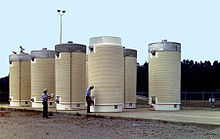External costs of energy technologies, part 2
Where does waste = external costs?

Dry cask storage area (Photo: NRC)
Part 1 of this article, which appeared here on December 28, made the point that the nuclear power industry sequesters its nuclear "waste." The same statement of high standard cannot be said for applications of combustion, whether it be from coal, petroleum products, or methane (ingeniously marketed as natural gas). This is where external costs come into play. External costs can come in many forms, including from public health impacts, environmental impacts, and reductions in people's quality of life. As I've been writing this blog post, the Pittsburgh Post-Gazette newspaper has been in the middle of publishing an eight-part series of articles titled "Mapping Mortality," based on a year-long investigation. The articles describe the many external costs of the coal plants lining the Ohio River valley in western Pennsylvania.
Just as nuclear engineers can express their disappointment over what may be the final chapter in the 28-year history of the Yucca Mountain repository project, there is similar disappointment by others over the fate of Little Blue Lake, which was originally advertised decades ago by Penn Power as eventually becoming a recreation area with beauty matching the rest of western Pennsylvania's  picturesque landscape. Thirty-five years later, Little Blue Lake garners descriptions such as "moonscape," which highlights its desolate wasteland feel. It currently contains 100 million tons of fly ash and calcium sulfate-the waste from coal power. The sheer volume of this 1000-acre site that crosses state lines dwarfs the volume of waste from the nuclear energy industry. Where are the boats and skiers that were supposed to enjoy Little Blue Lake? After all, it's just ash, right? I use ashes in my compost for my home garden.
picturesque landscape. Thirty-five years later, Little Blue Lake garners descriptions such as "moonscape," which highlights its desolate wasteland feel. It currently contains 100 million tons of fly ash and calcium sulfate-the waste from coal power. The sheer volume of this 1000-acre site that crosses state lines dwarfs the volume of waste from the nuclear energy industry. Where are the boats and skiers that were supposed to enjoy Little Blue Lake? After all, it's just ash, right? I use ashes in my compost for my home garden.
 Fly ash is different, however, and a debate exists on whether it contains enough heavy metals such as arsenic and lead to be considered "hazardous waste" under U.S. Environmental Protection Agency regulations. The environmental groups such as the Sierra Club claim that the ground water is contaminated around the Little Blue Lake site, but the company that maintains the site says that it has met all regulations imposed on it, with an emphasis on safety. Some people will feel as though this exchange of public positions is similar to the back-and-forth that goes on regarding tritium in groundwater around nuclear plants, so this example of one of the largest of 39 coal-ash dump sites in the United States may not be compelling enough for some people. Rather than describing why I'd be willing to drink the water contaminated with tritium that was found to have leaked from the Vermont Yankee nuclear power plant or anywhere else, I'll move on and stay on topic.
Fly ash is different, however, and a debate exists on whether it contains enough heavy metals such as arsenic and lead to be considered "hazardous waste" under U.S. Environmental Protection Agency regulations. The environmental groups such as the Sierra Club claim that the ground water is contaminated around the Little Blue Lake site, but the company that maintains the site says that it has met all regulations imposed on it, with an emphasis on safety. Some people will feel as though this exchange of public positions is similar to the back-and-forth that goes on regarding tritium in groundwater around nuclear plants, so this example of one of the largest of 39 coal-ash dump sites in the United States may not be compelling enough for some people. Rather than describing why I'd be willing to drink the water contaminated with tritium that was found to have leaked from the Vermont Yankee nuclear power plant or anywhere else, I'll move on and stay on topic.

Spent fuel shipping cask mounted on a railroad car
Non-nuclear industries have the luxury of not having to create indestructible containers in which to dispose of their waste, as does the nuclear power industry. Little Blue Lake is one example, and another clearer example is the smoke stacks at fossil fuel plants and refineries that spew their waste into the atmosphere. Western Pennsylvania is again an excellent example of the effects of this non-containment of waste, and the Pittsburgh Post Gazette has done a lot of legwork in describing the phenomenon through Mapping Mortality. It only confirms through statistically significant data what we all intuitively know as true: breathing polluted air is bad for us.
There are 32 facilities in Allegheny County (around Pittsburgh, Pa.) alone that the state of Pennyslvania's Health Department labels as "major sources" of air pollution because annually these facilities emit 10 tons or more of a hazardous air pollutant, or 25 tons of what they define as "criteria pollutants" such as ozone, lead, sulfur dioxides, nitrogen dioxides, and carbon monoxide. Ten tons of hazardous air pollution times 32 qualifying polluters in Allegheny County equals 320 tons of airborne hazardous pollutants, separate from the sludge that the 32 facilities pour into waste sites.
When we consider how beautiful Pittsburgh looks today, versus how obvious the air pollution was in the early 1980s when the southside district was still lined with steel mills, the plainly observable fact that 320 tons per year is less severe than the pollution levels of 30 years ago (when many scrubbing technologies didn't exist and were not required) indicate that the external costs of utilizing combustion of coal or even the less-polluting methane gas have affected the way our society operates. Clusters of death, respiratory problems, cancer, and other sicknesses related to these technologies' ability to release massive amounts of waste into the atmosphere don't enter into the equation on the cost of energy in conventional models. As the EPA adds regulations based on the Clean Air Act, pollutants are reduced, but from a technological standpoint, it's not reasonable to suggest that they can be reduced to zero, or to some level that could even remotely compete with the nuclear energy industry's ability to contain its "waste."
As a reminder of the principle of Conservation of Mass, note that any of that particulate that doesn't end up in the air just becomes more waste for places like Little Blue Lake. Either way, there are significant external costs to the community.
(Part 3 of this three-part article will appear on December 30, on the ANS Nuclear Cafe. Part 1 appeared on December 28 and is available here.)
***
The views expressed here are my own and do not necessarily represent the positions, strategies or opinions of Westinghouse Electric Company LLC.

Wharton
Art Wharton is a senior project engineer at Westinghouse Electric Company LLC in the Nuclear Power Plants product line. He is a member of the ANS Planning committee, the Operations and Power Division Program committee, is a Pittsburgh Local Section past chair, and is a guest contributor to the ANS Nuclear Cafe.






